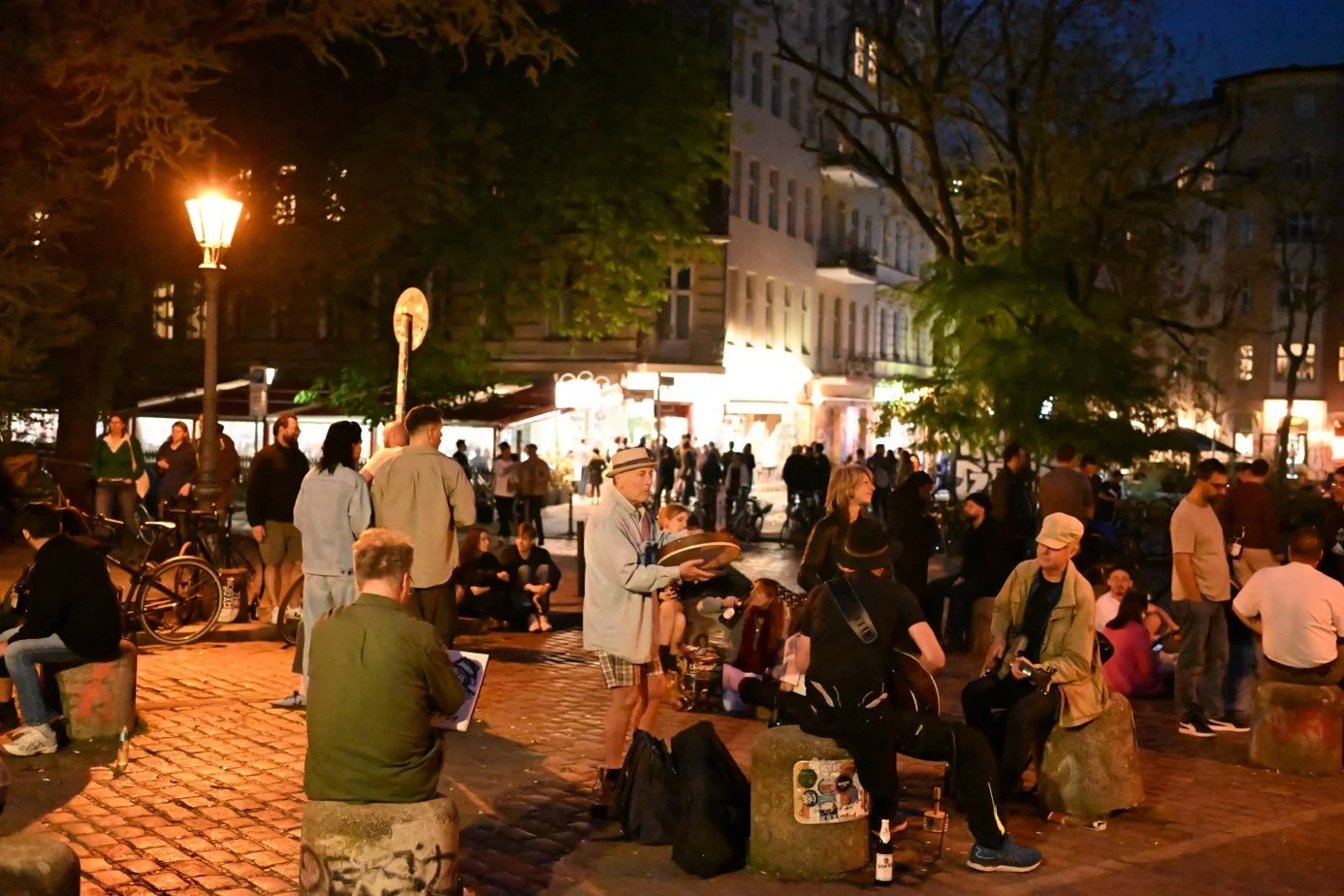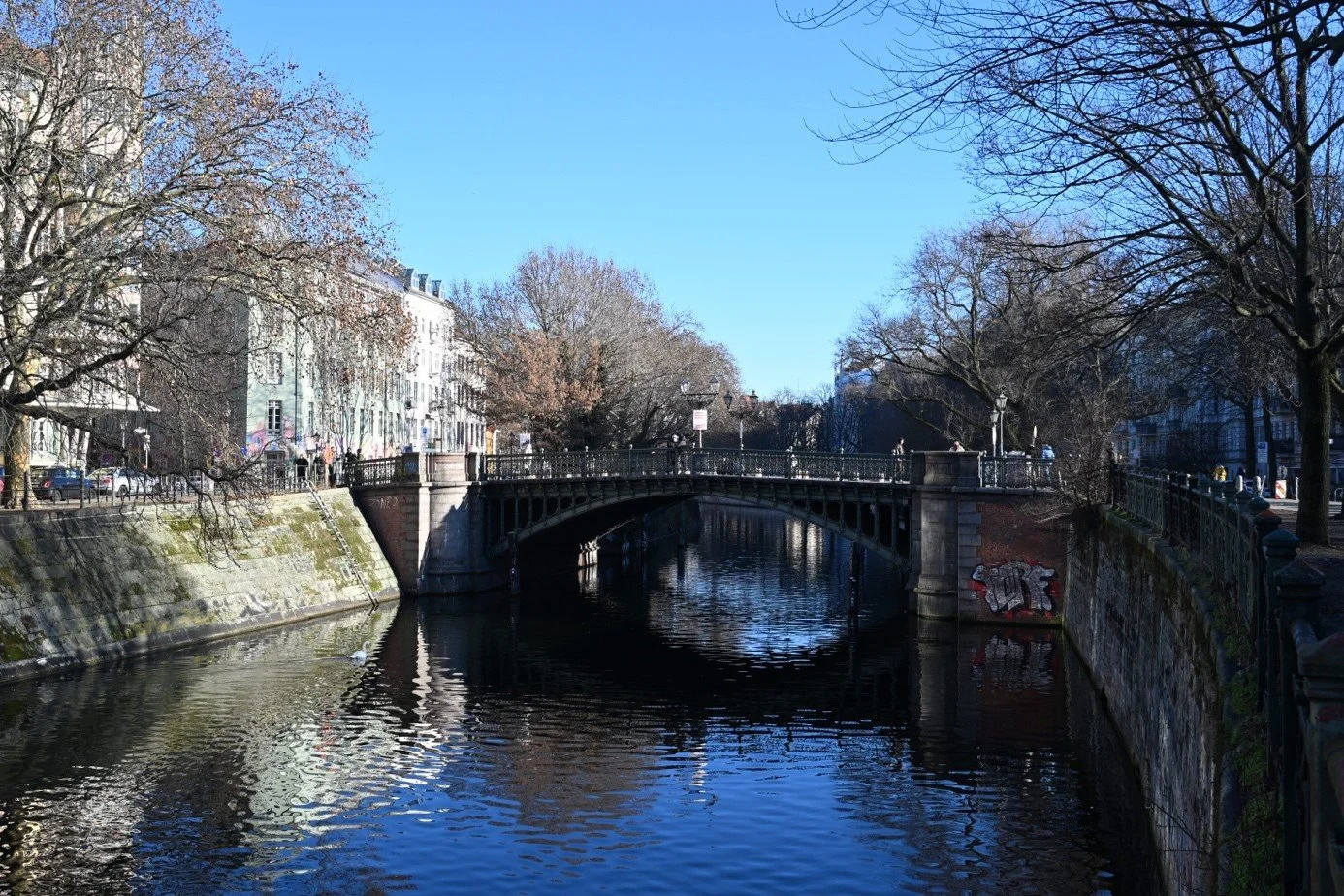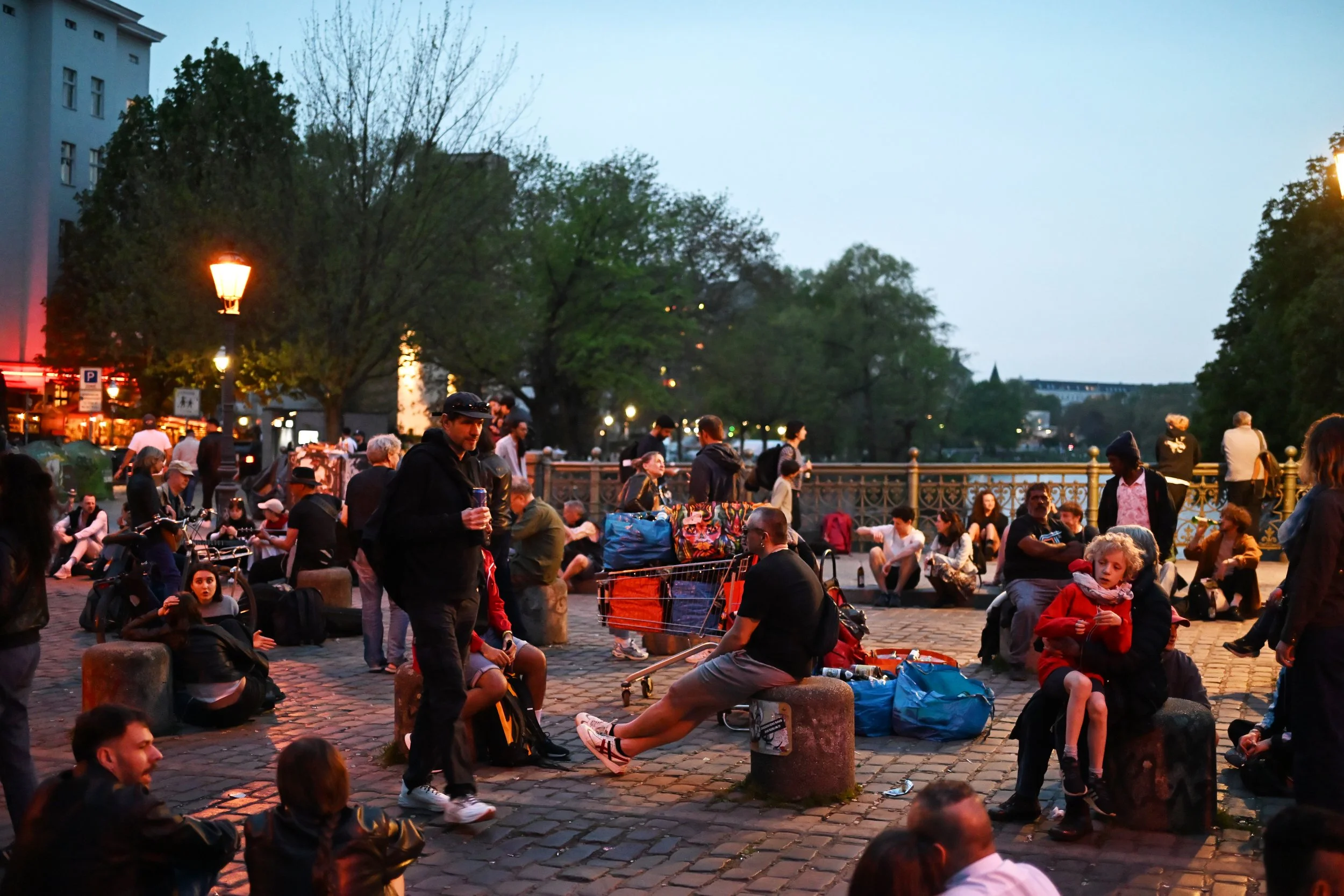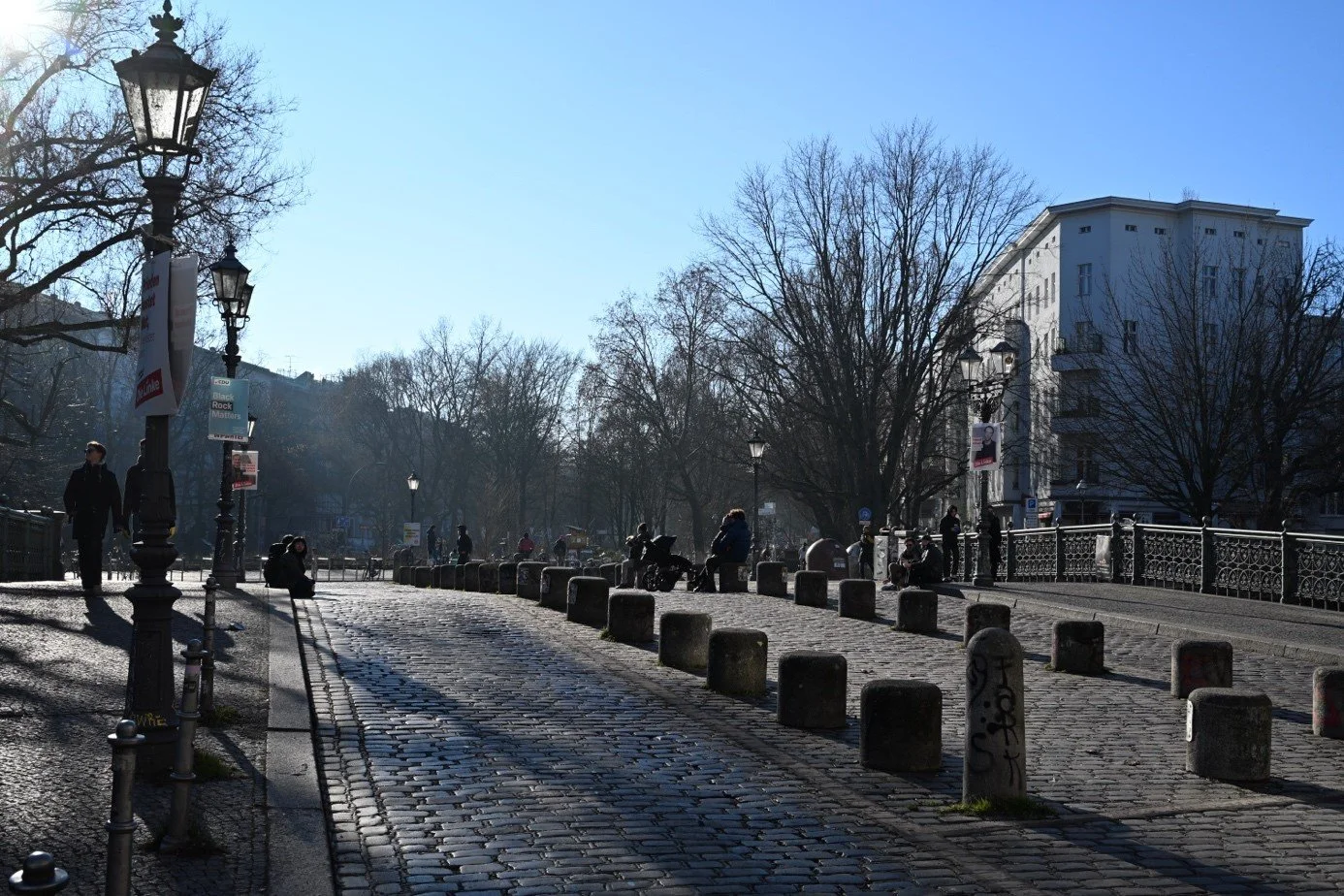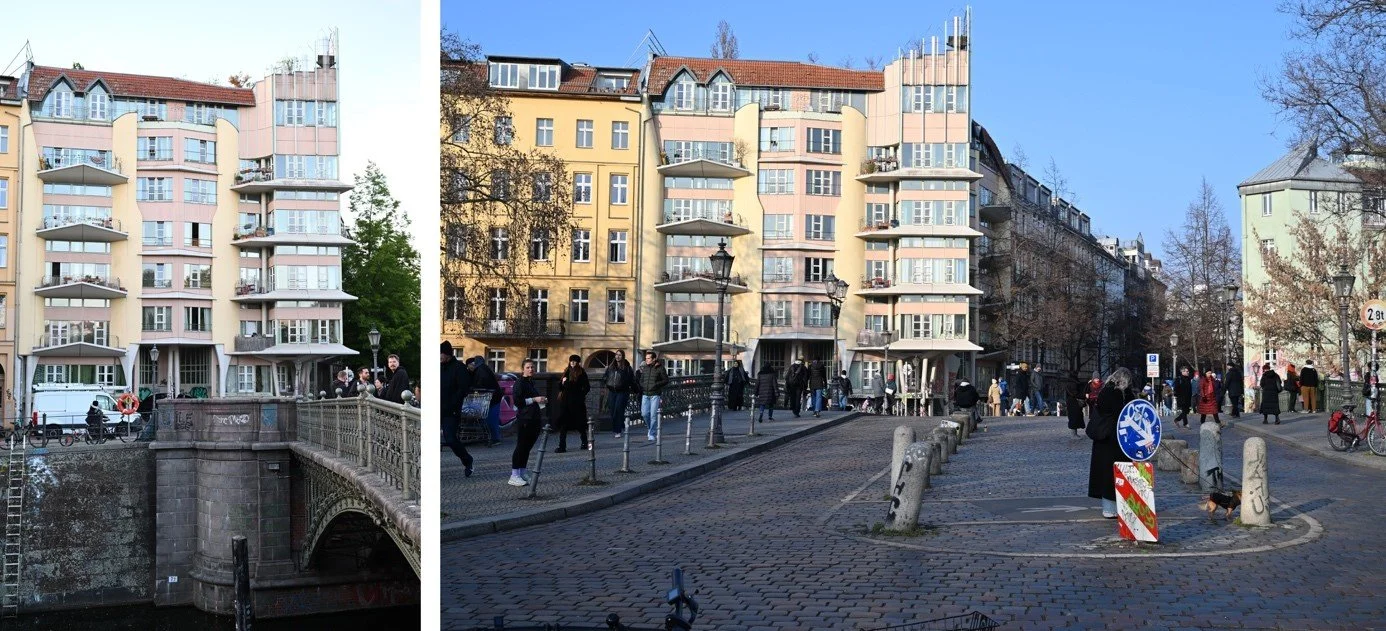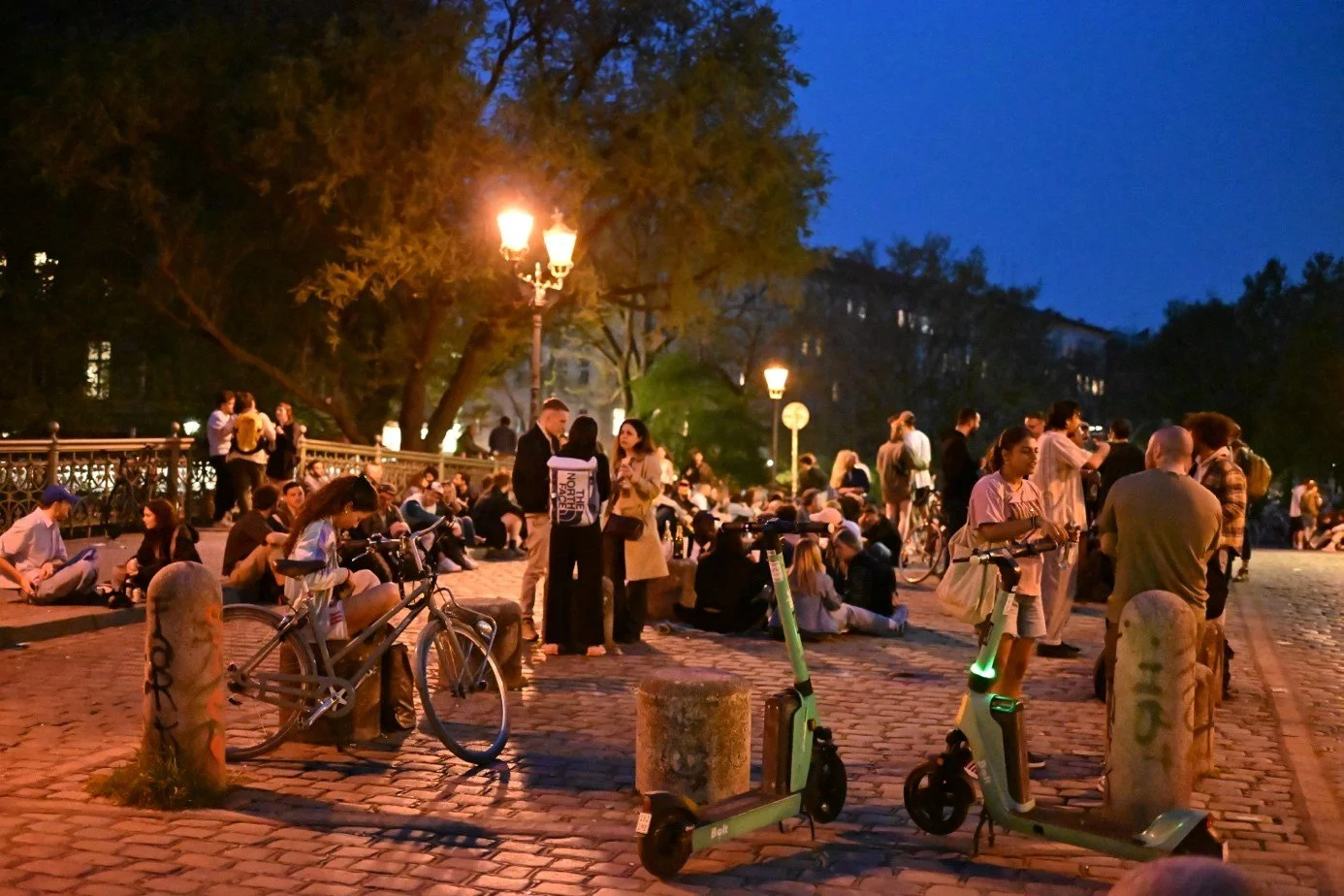In Search for Resonance in Architecture: Observations in Kreuzkölln
Björn Lundell
Qualities of place and architecture extend beyond mere functionality and require deeper thought and analysis. To understand why certain locations within a city become places that attract, inspire, and encourage activity and vibrancy, it is necessary to recognize how people use, relate to, experience, and interact with their urban environment. Drawing on the German sociologist Hartmut Rosa’s (2016) theory of resonance I have studied public life on Admiralbrücke, a vibrant and multifaceted location in Kreuzkölln, Berlin - how the human instinct to create, organize, and shape the built environment fosters meaningful relationships with public space. Highlighting activities, traces of activity, and creative engagement on Admiralbrücke and how these relate to the bridge’s architectural design and urban context. By emphasizing resonance in architecture, a more holistic approach to urban planning and design can be achieved.
Admiralbrücke in the evening
Alternative ways of thinking about architecture, city planning, and urban design
In the context of architecture, city planning, and urban design I suggest a greater focus on the dynamic relationship between people and public space. Rather than viewing urban environments as static or solely functional, it is critical to observe inhabitants’ everyday activities and interactions, and how they continuously shape and redefine the urban landscape. This perspective advocates for more flexible and responsive planning strategies that acknowledge the evolving nature of public life. By creating spaces that allow for open-ended use and unanticipated engagement, planners and architects can invite residents to participate in the ongoing formation of their surroundings. Such an approach leads to environments that are more vibrant, engaging, and attuned to human life.
Admiralbrücke - looking east
Systematic observations of Admiralbrücke in Kreuzkölln, Berlin, through the lens of Hartmut Rosa’s theory of resonance, have confirmed this idea. In Rosa’s book Resonance: A Sociology of Our Relationship to the World, Rosa critiques the alienating effects of late modernity, characterized by relentless acceleration, efficiency, and control. In contrast to alienation - where the world is experienced as distant or unresponsive - resonance describes a reciprocal and dynamic relationship between individuals and their environment - whether other people, nature, art, or work. Rosa asserts that “resonance is not an echo, but a responsive relationship,” where both individuals and the world are transformed through mutual interaction. Rosa´s key idea is that people do not simply seek control over their environment; rather, they long for resonance - a meaningful and reciprocal relationship with the world. This concept offers a powerful framework for rethinking urban design: rather than striving for efficiency alone, cities should be shaped to foster meaningful, life-affirming encounters.
Admiralbrücke serves as a fitting case study for this purpose. Once defined by its original infrastructure function, the bridge has evolved into a socially significant urban artifact, echoing the idea of the Italian architect Aldo Rossi (1984), that some structures, due to their form and history, transcend their initial use and become lasting elements of the urban fabric. Unlike other nearby bridges, Admiralbrücke has become a place of gathering, expression, and creative exchange - qualities that exemplify resonance. Located in Kreuzkölln, a hybrid district that fuses the identities of Kreuzberg and Neukölln, the bridge embodies the area's cosmopolitan character and fluid cultural landscape. Kreuzkölln has emerged as a new urban hub marked by diversity, street culture, and a vibrant international community.
This transformation raises key questions: What architectural and contextual qualities make this possible? And how can architects and urban planners design spaces that invite such human interaction over time? The findings suggest a shift in priorities is needed. Rather than programming spaces with fixed functions, designers should consider architecture as a framework for possibility - prioritizing openness, material presence, and craftsmanship. Embracing uncertainty, designing for openness, and emphasizing architectural quality over rigid programming can help cultivate environments that are not only functional but also alive with human interaction and meaning. A guiding principle could be “more architecture, less programming,” where spatial design encourages agency and resonance rather than merely prescribing use. It is about redefining the goals of contemporary urbanism - not just to build efficient cities, but to cultivate spaces that are emotionally, socially, and experientially alive.
Spring evening on Admiralbrücke 2025
Genius loci and the emergence of self-defining urban places
The Norwegian architect Christian Norberg-Schulz’s (1980) concept of genius loci, or “spirit of place,” provides a crucial theoretical framework for understanding the social and architectural character of Admiralbrücke and its surrounding area. He expands upon the Roman notion of the “spirit of place,” defining a place as a space with a distinct character -shaped by both natural and cultural elements - that human beings engage with in their everyday lives. This phenomenological approach is suitable to explore the unique atmosphere of the Admiralbrücke, and the evolving identity of the area contributing to its success as a self-defining and self-creating place.
The development of the Kreuzkölln area, where Admiralbrücke is located, traces back to the construction of the Landwehrkanal in the mid-19th century. Between 1871 and 1905, the neighbourhood developed rapidly, forming a dense urban fabric typical of Berlin at the time: multi-story tenement buildings with dense and dark inner courtyards in large, massive blocks (the Berliner Mietskasernen.) Workshops and factories constituted part of the urban environment. The spacious dimensions of the urban plan and the integration of greenery among the massive stone buildings can be attributed to the landscape architect Peter Joseph Lenné (1789–1866). Although much of the original landscape has vanished, remnants are? Ful upprepning embedded in the topography and architectural legacy. Admiralbrücke, built between 1880 and 1882, is the oldest wrought-iron bridge spanning the canal, replacing an earlier wooden structure and forming part of Berlin’s larger planning vision under Hobrecht’s 1862 master plan. It connects Fraenkelufer and Planufer and has undergone a transformation from a piece of infrastructure into a social landmark, once more echoing Aldo Rossi’s notion of the “urban artifact”: a structure that transcends its initial function to become a permanent, identity-shaping element of the city.
During the Cold War, the neighborhood became marginalized due to its location near the Berlin Wall and the great distance to the more prestigious city center around Kurfürstendamm. But since the early 2000s, the term “Kreuzkölln” has emerged to describe the area’s growing cultural and social vitality in a dynamic junction between Kreuzberg and Neukölln. While Kreuzberg became associated with multiculturalism and progressive subcultures, Neukölln suffered from crime, urban decay, and social stigmatization. Despite - or perhaps because of - these tensions, the northern tip of Neukölln developed a distinct urban identity. As the researchers in the field of urbanism, Scott and Sohn (2018) note, Kreuzkölln grew into a cultural melting pot where “digital bohemians,” long-term residents, and diverse migrant communities coexist. Local initiatives and voices, such as the Drawing Friends blog (2010), capture this transformation, describing the area as a “problem area blossoming into a hip neighborhood.” In this context, Admiralbrücke has become more than a bridge—it is a living public space and a symbol of Kreuzkölln’s evolving genius loci.
The crest of Admiralbrücke - looking south
The American urbanist Jane Jacobs’ (1961) emphasis on observation as a method for understanding urban life is particularly relevant here. She advocated for cities to be shaped by the people who inhabit them, asserting that diverse, mixed-use environments foster safety and social engagement. Although Admiralbrücke lacks commercial activity itself, it is surrounded by varied urban uses that support Jacobs’ theory. Its open, accessible structure invites use in ways not dictated by strict programming - like how the Spanish Steps in Rome serve as a gathering space by virtue of its spatial qualities. The act of observing such spaces, as Jacobs encouraged, requires time, openness, and a willingness to see beyond planned outcomes. This attitude aligns with the German philosopher Walter Benjamin’s concept of the flaneur - the detached yet attentive urban observer, moving through the city to uncover its deeper rhythms and meanings. In the case of Admiralbrücke, this means recognizing the bridge not only as a piece of architecture but as a living element in the urban fabric, where space itself fosters human connection and resonance.
Architecture that fosters resonance
The architectural elements and spatial composition are critical dimensions to identify the qualities that foster resonance in the built environment. While emotional responses to space often stem from an immediate, atmospheric perception - as the Swiss architect Peter Zumthor (2006) notes, “We perceive atmospheres through our emotional sensibility” - a deeper understanding requires systematic and detailed architectural analysis. The area surrounding Admiralbrücke exemplifies how spatial design, material expression, and urban context converge to shape a distinctive and resonant atmosphere. The spatial configuration of Admiralbrücke offers a striking example of how architecture can transcend utility and foster meaningful interaction. The bridge serves not only as infrastructure but as a social and perceptual node within the urban fabric.
To the north, Admiralstraße leads toward Kottbusser Tor, while to the south, the view opens into a green urban corridor stretching along Grimmstraße. This setting includes tree-lined promenades, plazas, and linear parks, creating a lush and accessible public realm. From the crown of the bridge, the highest point in the area, panoramic sightlines extend in four directions, offering an expansive visual experience and a sense of openness rarely found in dense urban environments.
Admiralbrücke - looking west
Designed by Georg Pinkenburg and completed in 1882, Admiralbrücke spans 33 meters in length and 19.5 meters in width. Though originally intended for vehicular traffic, it now accommodates mostly pedestrians and cyclists. Its generous proportions, central cobblestone area, and flanking sidewalks enable the bridge to function as a hybrid space - both a thoroughfare and a plaza. The experience of being on a square emphasized by both its cobbled surface and the presence of four smaller architectural sections - two on each side - which add to the spatial richness and reinforce the bridge’s identity as more than just infrastructure. Thirty-seven low bollards line the center of the bridge, offering informal seating and reinforcing its use as a gathering place. This spatial flexibility supports Hartmut Rosa’s theory of resonance, enabling dynamic, reciprocal interactions between people and place.
Architectural and material details further enrich the experience of the space. The bridge’s decorative riveted iron construction is adorned with delicate, leaf-ornamented wrought-iron railings painted in a beautiful green color, signal human craftsmanship and aesthetic care. The visible craftsmanship in both the ironwork and stonework contributes to a deep sense of human artistry, offering rich visual and tactile experiences. Cast-iron plaques mark its name at the center, while historic candelabras and lanterns light the space at night, enhancing its atmosphere and historical presence. The diversity of paving materials on and around the bridge further adds to its distinctive character. A mix of paving stones, asphalt, spontaneous greenery, and exposed sandy soil, contributing to the informal and evolving atmosphere of the site. Thousands of bottle caps embedded in asphalt joints between the cobblestones, reveal traces of use and collective memory, underscoring the bridge’s role as a living public space rather than a static monument.
Surrounding buildings on both sides of the channel amplify this ambiance. Historic plaster facades from the late 19th and early 20th centuries frame the bridge with a consistent architectural rhythm, while a striking postmodern corner building by the Berlin architects Hinrich Baller and Inken Baller serves as a visual anchor, adding aesthetic variety while enhancing the site’s spatial identity. This eclectic but coherent urban environment reinforces what the American urban Planner Kevin Lynch (1960) refers to as a “node” - a place of concentrated activity and identity within the mental map of a city. While strong form is not strictly necessary for a space to be memorable, Lynch argues, “Where the space has some form, the impact is much stronger. The node becomes memorial.” Admiralbrücke exemplifies this principle: through thoughtful design, spatial openness, and architectural detailing, it has become more than a crossing point - it is a resonant space, emotionally legible and socially alive.
The postmodern corner building by Hinrich Baller and Inken Baller north of Admiralbrücke
Architecture that fosters resonance
In sum, the architecture of Admiralbrücke fosters resonance not through grand gestures, but through its sensitive integration of form, material, and spatial openness. These elements invite human engagement and anchor the bridge as a site of social meaning. This observation underscores the argument that architectural quality—when designed to support interaction, atmosphere, and perception - plays a vital role in shaping urban spaces that feels alive, meaningful, and responsive.
Admiralbrücke as an urban stage for everyday life and spontaneity
On a warm September afternoon, a street art performance offered a vivid example of how the bridge functions as an urban stage, welcoming spontaneous and improvised expressions of creativity. At the time of the observation, the bridge was populated by a diverse mix of individuals: three young men socialized and drank beer in the shade of the railing; an older man in sunglasses paused, perhaps to rest or admire the view; a well-dressed woman, possibly waiting for someone, sat comfortably on a bollard. Children climbed and played on the stone bollards, while a woman in jogging clothes took a break. A small group of friends gathered near the bridge entrance, chatting, and a cyclist crossed the bridge slowly. In total, around 35 people were present - a typical afternoon scene that would be even livelier on sunny weekends or spring evenings, when the bridge sometimes transforms into the setting of a crowded street party.
At this moment, the bridge’s latent potential for performative urban life was activated. Suddenly, a few people arrive carrying three rubbish bins, with brooms and brushes sticking out of them. They place their bins precisely on the bridge between the two rows of stone bollards running along its length. Additional performers - indistinguishable from regular visitors - picked up the brooms, and a performance commenced. Initially mistaken for a civic cleaning crew, the performers soon revealed their artistic intent. Their actions drew attention; a cyclist stopped, an elderly woman sitting nearby looked confused, and the children watched with curiosity. Two women in grey dresses, with long, flesh-colored tails trailing behind them, hinted at their theatrical roles.
Without formal staging or introduction, a performance unfolded - an improvised street theatre piece addressing themes of public responsibility and urban hygiene, symbolized by performers dressed as rats and sanitation workers. The theme, centering on collective responsibility to keep the city clean, was communicated playfully and vividly. The crowd - composed of individuals who just happened to be on the bridge - became an impromptu audience. Costumed as sanitation workers and rats, the performers conveyed a socially relevant message that resonated with the space and its users. It reflected real issues in Berlin, such as the challenges of cleanliness in areas like Hermannplatz, known for being avoided at night due to rat infestations. This moment captured Admiralbrücke’s capacity to act as both a social and performative space, where the boundary between daily life and artistic expression can be fluid and dynamic.
Street theater on Admiralbrücke 2025
A similar transformation occurred on a bright, unseasonably warm Sunday morning in January. The bridge filled with the relaxed tempo of weekend life, people strolled leisurely, some with prams or dogs. Some friends gathered by the railing to talk; A man sat on one of the bollards with his eyes closed and his face turned towards the winter sun.; a woman sat on another one and read a book. Nearby, a homeless person arranged belongings in an alcove of the postmodern corner building - a reminder of the complexities of urban space and the coexistence of different social realities. Passers-by carried flowers or coffee, contributing to the calm, communal rhythm of the scene. This ordinary calm was interrupted in a gentle, joyous way when a well-dressed couple appeared, a portable speaker slung over the man’s shoulder, playing The 5th Dimension’s “Let the Sunshine In.” Mid-bridge, they began to dance, smiling and inviting others to join. Two women accepted, and for a few minutes, the bridge became a site of spontaneous celebration - a fleeting transformation that spread warmth and connection among strangers. The couple danced away, leaving behind a feeling of happiness and shared delight.
The atmosphere of Admiralbrücke can be described as folksy, warm, social, atmospheric, and expectant
Interaction, experience, and the conditions for urban resonance
Building on the site-specific investigation of Admiralbrücke, the findings increasingly point to a constellation of spatial and social characteristics that foster a resonant relationship between individuals and their urban environment. At the core of this resonance is the interplay between physical place and lived experience. Admiralbrücke’s elevated topographical position, offering panoramic views of the canal and gently sloping streets, anchors it within the broader urban fabric while also establishing its unique identity. The site’s architectural form and exposure to sunlight are not incidental but reflect intentional design decisions that enhance the perceptual and atmospheric qualities of the space. Norberg-Schulz’s concept of genius loci - the spirit of a place shaped by natural and cultural dimensions - proves especially relevant in articulating these nuanced relationships. When describing the atmosphere of Admiralbrücke, key is the holistic experience of the site and its situational context. The Finnish architect Juhani Pallasmaa (2014) articulates this phenomenon: “Paradoxically, we grasp the atmosphere before we identify its details or understand it intellectually. In fact, we may be completely unable to say anything meaningful about the characteristics of a situation, yet have a firm image, emotive attitude, and recall of it.”
Historic lanterns on Admiralbrücke light the space at night, enhancing its atmosphere and historical presence
The atmosphere of Admiralbrücke can be described as folksy, warm, social, atmospheric, and expectant. The inviting sense encouraging gathering, lingering, and creative appropriation. The under-programmed space gives it an informal character with “unfinished” qualities present in ruins, where imagination and participation are more freely expressed, strengthening the bond between people and place.
Observations of human activity at Admiralbrücke confirms its role as a destination with a distinctive local culture - an informal yet vibrant social node in the city’s collective consciousness. Whether through spontaneous performances, casual gatherings, or moments of stillness and reflection, the bridge fosters a sense of shared experience and community. The site functions not merely as a crossing, but as a destination where social roles and individual expressions unfold in public. These interactions point to what might be termed a “living culture,” where identity is sustained through continuous, collective presence and engagement. Importantly, even those who do not actively participate in performances - such as those who simply pause to socialize, observe pass through - contribute to the site’s ongoing cultural production. A place where people can experience both belonging and resonance.
Architecture as a destination
Yet, resonance is not experienced equally by all. Individual experiences of space vary widely, shaped by personal histories, social positions, and emotional states. Nonetheless, the social context that emerges in places like Admiralbrücke - through unprogrammed interactions, sensory engagement, and accessibility demonstrates how certain spatial conditions can foster belonging and creative co-creation. Although resonance can be difficult to quantify, clear indicators include high levels of activity, interaction with the environment, and creative engagement. These qualities are present at Admiralbrücke, along with other characteristics that contribute to resonance. For instance, the opportunity for individuals to navigate urban spaces freely, choosing their own paths. Whether one chooses to walk on gravel, asphalt, or stone, to sit on a bench or on a railing, these small acts of agency contribute to an embodied sense of place. Additionally, urban environments that offer views of the cityscape foster a sense of connection to a larger context.
In this way, Admiralbrücke exemplifies how thoughtful architecture, and adaptive urban design can support resonance. The bridge offers a case study in how spatial diversity, material expressiveness, and opportunities for co-creation can collectively nurture a sense of connection between people and place. These micro-level interactions grounded in sensory perception and social context accumulate to shape broader patterns of urban liveliness, identity, and emotional investment.
Observation of resonance 2025
Toward a resonant urban future
The study of resonance in urban environments highlights the critical need for architecture and planning to move beyond rigid functionality and instead embrace flexibility, openness, and human experience. Studying existing urban environments that have undergone or are undergoing slow transformation presents valuable opportunities to explore the concept of resonance in architecture and urban design. Processes of change - whether subtle or significant - offer moments where the function and meaning of public spaces can be reconsidered, redefined, and co-created by residents. Through everyday activities and social interactions, residents influencing the evolution of place from the bottom up. At the heart of this lies a fundamental human impulse: the desire to interact with, shape, and co-create one’s immediate surroundings.
Successful urban design must accommodate both change and continuity, enabling informal use, creative expression, and long-term cultural layering. As Aldo Rossi redan presenterad som Italian (1982) notes, the city is the locus of collective memory, and its physical form must reflect that depth. When urban environments fail to support resonance - through alienating design or lack of human scale - people often create their own cultural frameworks in response, reinforcing the value of public space as a medium for identity and belonging. The challenge for contemporary urbanism is to resist over-determination and instead trust in the gradual, organic evolution of place. As the researchers in the field of urbanism Bob Giddings and Robert Rogerson (2023) argue, reversing the trend of homogenized, large-scale development requires re-centering the unique character of place and prioritizing the lived experiences of communities. Planning for resonance means designing cities not as static systems, but as dynamic, inclusive, and co-created environments. A truly resonant urban future calls for a planning paradigm that values slowness, openness, and cultural authenticity. It is essential to continue exploring models of urban development that provide space for residents’ creativity, embrace uncertainty, and foster authentic connections between people and place, ensuring cities remain vital, resilient, and deeply human.
The text is based on a paper presented at the CIB World Building Congress at Purdue University in 2025. Björn Lundell is an artist and architect, based in Berlin.
References
Anon. Drawingfriends 2010, Drawingfriends.blogspot.nl.
Artega, P. Kreuzkölln, O cómo inventarse un Barrio en Berlin, 2012 (www.berlinamateurs.com/kreuzkolln-o-como-inventarse-un-barrio-en-berlin).
Giddings, B., Rogerson, R J. Giddings. B and Rogerson. R. J. Conclusion and future scenarios, The Future of the city Center – Global Perspectives, 2023 Routledge, London, New York, 258.
Jacobs, J. The Death and Life of Great American Cities, 1961, Random House, New York, 238.
Lynch, K. The Image of the City, 1960, M.I.T Press, Camebridge Massachusetts, 76.
Norberg-schulz, C. Genius Loci: Toward a Phenomenology of architecture, 1980, Rizzoli, New York, 6; 18.
Pallasmaa, J. Space, Place and Atmosphere - Emotion and Peripheral perception in architectural experience, 2014, Lebenswelt, Milano, (https://doi.org/10.13130/2240-9599/4202), 232.
Rosa, H. Resonanz: Eine Soziologie der Weltbeziehung, 2016, Suhrkamp Verlag, Berlin, 174.
Rossi, A. The Architecture of the City, 1984, M.I.T Press, Camebridge Massachusetts, 130.
Sarrazin, T. Deutschland schafft sich ab, 2010. Deutsche Verlags-Anstalt, Munich.
Scott, J., Sohn, C. Place-making and the bordering of urban space. Interpreting the emergence of new neighbourhoods in Berlin and Budapest, 2018, European Urban and Regional Studies, (https://www.researchgate.net/publication/324253547), 7.
Zumthor, P. Atmosphären - Architektonische Umgebungen. Die Dinge um mich herum, 2006, Birkhäuser, Basel, 13.


